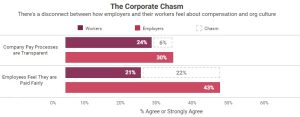The last time you looked at your company’s online reviews, did you notice any entries where someone listed “pay” as a downside of working at the company? Or, how many alumni have mentioned they would not recommend your company because of pay?
Whether you have a pay perception issue you want to fix, or simply want to maintain high employee satisfaction around pay, it’s likely there are a few things you can do to ensure your employees feel better about their deal with your company.
PayScale research found that only one in five employees feel like they’re fairly paid. When we asked employees about their organization’s pay process, just 24% of employees said their company’s  pay processes are transparent. Employers (including HR managers and compensation pros) don’t feel much better either; just 30% of employers said their company has transparent pay processes.
pay processes are transparent. Employers (including HR managers and compensation pros) don’t feel much better either; just 30% of employers said their company has transparent pay processes.
So, how do you build more trust with employees and managers around compensation so they feel better about their pay? With the advent of HR new technologies, one of the easiest ways to do so is to stop using the traditional pay structure with broad-based ranges and, instead, implement job-based ranges which define one range for each position at the company.
Shortcomings of a grade-based pay structure
The grade-based compensation structure has been around for a long time. It involves setting up multiple levels and fairly broad ranges for various levels at the company. Each position is then slotted into a certain level, based on the scope of the role, level of authority, skills required to perform the role and tenure.
In the last few years, many customers have told us that they’ve moved away from this pay structure because it created a host of cultural issues and unnecessary roadblocks on their path towards greater pay transparency.
According to customers, a grade-based pay structure created “grade envy,” and fostered confusion among managers and employees about the market value of their positions. In addition, this approach produced tension between HR and hiring managers about whether a job is priced “right.” The hiring process was slowed because of back-and-forth conversations between HR and hiring managers to reach consensus on the price / range / grade for a role.
Ultimately, many organizations implemented job-based ranges in order to incorporate more aspects influencing pay for a position, and to bring managers into the pay process. Job-based ranges ensured every employee better understood how their pay was determined and where they fit within the pay range for their specific position.
Pay grades created “grade envy”
American Enterprise Group, Inc. (AEG), has seven insurance company subsidiaries under the American Republic, Great Western and Medico brands. American Enterprise is based in Des Moines, IA and employs approximately 500 people in their various offices in the U.S.
According to Dana King, HR business partner at AEG, the company decided to abandon grade-based pay ranges because she was tired of having repetitive conversations with hiring managers about why a position is in grade X instead of grade Y.
Dana realized that using pay grades contributed to grade envy. In this structure, dozens of different jobs were assigned to the same pay grade, even though there are often significant differences among these jobs. Employees who heard the explanation, “Your job is assigned to grade X because of factors A, B and C” weren’t satisfied with the answers they got. Employees would ask HR, “How do I move up?”
At the end of the day, Dana and her fellow executives most wanted to ensure every employee was truly paid competitively for the various skills and talents they brought to the organization.
When AEG switched to job-based ranges, it became easier for HR to go to each manager and explain how they priced a position. Now, Dana can easily say, “The market data for this job is X, Y, Z,” rather than saying it’s assigned to Grade X. This saves both parties from coming back and having a conversation around why a job is assigned to Grade X, when the market data is saying it should be somewhere else.
Communicating job-based pay is easier
According to Brian Webber, PayScale’s in-house compensation expert, the primary reason PayScale uses job-based ranges is it empowers a company to clearly communicate pay decisions to employees in order to build more trust.
These days, employees expect a lot of information about how pay decisions impacting their compensation were made. They crave context and want information including the range for their role, where they are in the range and why, how they can move up in the range, and how the market is trending for their role. Job-based ranges can provide for more of this important context than pay grades.
It’s important to give employees more insight about their pay. So, it’s best for both employees and your business if your employees are able to have transparent, fact-based conversations about pay and/or career development with their manager whenever they think it’s merited. A shift to job-based pay ranges can help employers get there and foster deeper, more trusting relationship with employees as a result.
